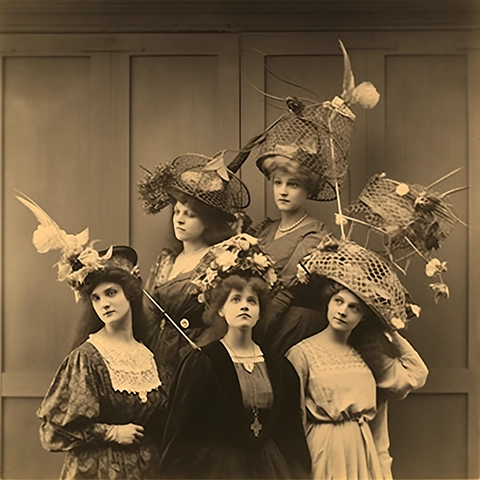In the early 20th century, society’s fascination with eccentricities and curiosities knew no bounds. Amidst the backdrop of the rapidly changing world in 1911, a peculiar phenomenon known as “The Society of Extraordinary Hats” emerged, captivating the imagination of people and laying the foundation for the future of unconventional entertainment.
This society was a unique gathering of women who dared to defy convention by wearing the most bizarre and extravagant hats, often adorned with oddities that left spectators in awe. Women from various walks of life came together, united by their love for making a fashion statement that could not be ignored.
One of the most iconic members of this society was a woman who took eccentricity to a new level. She wore a hat adorned with a birdcage, inside of which perched a living, breathing bird. This audacious display of fashion turned heads and became the talk of the town. Audiences were awestruck by the audacity and creativity displayed by these women in their choice of headwear.
The Society of Extraordinary Hats attracted the attention of people from all walks of life. Crowds would gather at public events to witness these women and their head-turning ensembles. It was more than just a fashion statement; it was a testament to the bold spirit of an era marked by rapid societal and cultural shifts.
One of those who attended one of these exhibitions was LeRoy Robert Ripley, a young newspaper cartoonist and adventurer. Ripley was so fascinated by the extraordinary hats and the spectacle they created that he was inspired to embark on a journey to uncover and document bizarre facts and curiosities from around the world. This fascination with the unconventional would later culminate in the creation of “Ripley’s Believe It or Not.”
Ripley’s “Believe It or Not” franchise, which began as a newspaper cartoon feature, soon evolved into books, radio shows, museums, and television programs, captivating audiences for generations with its collection of extraordinary and often inexplicable facts. This popular phenomenon that Ripley initiated can be traced back to the inspiration he found in the remarkable eccentricities of The Society of Extraordinary Hats.
The legacy of The Society of Extraordinary Hats, though relatively short-lived, continues to serve as a symbol of the boundless human creativity and the willingness to challenge convention in the quest for individuality and self-expression. It reminds us of a time when society celebrated the eccentric, and in doing so, laid the foundation for one of the most enduring franchises in the world of curiosities, Ripley’s Believe It or Not.

